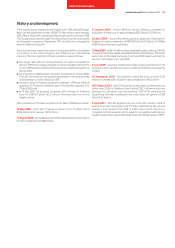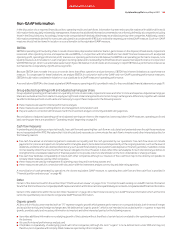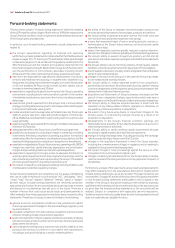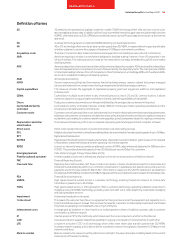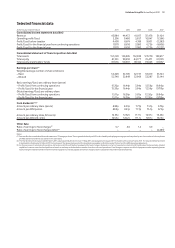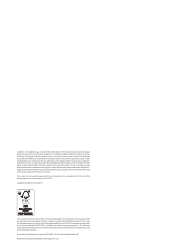Vodafone 2011 Annual Report Download - page 151
Download and view the complete annual report
Please find page 151 of the 2011 Vodafone annual report below. You can navigate through the pages in the report by either clicking on the pages listed below, or by using the keyword search tool below to find specific information within the annual report.
Vodafone Group Plc Annual Report 2011 149
Additional information
Denition of terms
2G 2G networks are operated using global system for mobile (‘GSM’) technology which offer services such as voice,
text messaging and basic data. In addition, all the Group’s controlled networks support general packet radio services
(‘GPRS’), often referred to as 2.5G. GPRS allows mobile devices to access IP based data services such as the internet
and email.
3G A cellular technology based on wide band CDMA delivering voice and data services.
4G 4G or LTE technology offers even faster data transfer speeds than 3G/HSPA, increases network capacity and is able
to deliver sustained customer throughputs of between 6-12 Mbps in real network conditions.
Acquisition costs The total of connection fees, trade commissions and equipment costs relating to new customer connections.
ADR American depositary receipts is a mechanism designed to facilitate trading in shares of non-US companies in the
US stock markets. The main purpose is to create an instrument which can easily be settled through US stock market
clearing systems.
ADS American depositary shares are shares evidenced by american depositary receipts. ADSs are issued by a depositary
bank and represent one or more shares of a non-US issuer held by the depositary bank. The main purpose of ADSs
is to facilitate trading in shares of non-US companies in the US markets and, accordingly, ADRs which evidence ADSs
are in a form suitable for holding in US clearing systems.
AGM Annual general meeting.
ARPU Service revenue excluding fixed line revenue, fixed advertising revenue, revenue related to business managed
services and revenue from certain tower sharing arrangements divided by average customers.
Capital expenditure This measure includes the aggregate of capitalised property, plant and equipment additions and capitalised
software costs.
CDMA Code-division multiple access refers to any of several protocols used in 2G and 3G communications. It allows
numerous signals to occupy a single transmission channel, optimising availability of bandwidth.
Churn Total gross customer disconnections in the period divided by the average total customers in the period.
Controlled and jointly
controlled
Controlled and jointly controlled measures include 100% for the Group’s mobile operating subsidiaries and the
Group’s proportionate share for joint ventures.
Customer costs Customer costs include acquisition costs, being the total of connection fees, trade commissions and equipment costs
relating to new customer connections, and retention costs, being the total of trade commissions, loyalty scheme and
equipment costs relating to customer retention and upgrades, as well as expenses related to ongoing commissions.
Depreciation and other
amortisation
This measure includes the profit or loss on disposal of property, plant and equipment and computer software.
Direct costs Direct costs include interconnect costs and other direct costs of providing services.
DSL A digital subscriber line which is a fixed line enabling data to be transmitted at theoretical peak speeds of up to 16 Mbps.
DTT Digital terrestrial television.
EBITDA Operating profit excluding share in results of associates, depreciation and amortisation, gains/losses on the disposal
of fixed assets, impairment losses and other operating income and expense.
EDGE In most our networks we also provide an advanced version of GPRS called enhanced data rates for GSM evolution
(‘EDGE’). This provides download speeds of over 200 kilobits per second (‘kbps’) to customers.
Emerging markets India, Vodacom, Egypt, Turkey, Ghana, Qatar and Fiji.
Fixed broadband customer A fixed broadband customer is defined as a physical connection or access point to a fixed line network.
FRC Financial Reporting Council.
Free cash flow Operating free cash flow after cash flows in relation to taxation, interest, dividends received from associates and
investments and dividends paid to non-controlling shareholders in subsidiaries but before licence and spectrum
payments and for the year ended 31 March 2011 other items in respect of: the UK CFC settlement, tax relating to
the disposal of China Mobile Limited, the SoftBank disposal and the court deposit made in respect of the India tax case.
FSA Financial Services Authority.
HSDPA High speed downlink packet access is a wireless technology enabling theoretical network to mobile data
transmission speeds of up to 43.2 Mbps.
HSPA High speed packet access or third generation (‘3G’) is a wireless technology operating wideband code division
multiple access (‘W-CDMA’) technology, providing customers with voice, video telephony, multimedia messaging
and high speed data services.
Impairment A downward revaluation of an asset.
‘in the cloud’ This means the customer has little or no equipment at their premises and all the equipment and capability is run
from the Vodafone network instead. This removes the need for customers to make capital investment and instead
they have an operating cost model with a recurring monthly fee.
Interconnect costs A charge paid by Vodafone to other fixed line or mobile operators when a Vodafone customer calls a customer
connected to a different network.
IP Internet protocol (‘IP’) is the method by which data is sent from one computer to another on the internet.
LAN A local area network supplies networking capability to a group of computers in close proximity to each other.
LTE Long-term evolution (‘LTE’) is 4G technology which offers even faster data transfer speeds than 3G/HSPA,
increases network capacity and is able to deliver sustained customer throughputs of between 6-12 Mbps in real
network conditions.
Mark-to-market Mark-to-market or fair value accounting refers to accounting for the value of an asset or liability based on the current
market price of the asset or liability.


